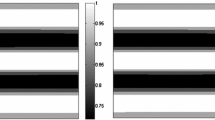Abstract
We consider two models which were both designed to describe the movement of eukaryotic cells responding to chemical signals. Besides a common standard parabolic equation for the diffusion of a chemoattractant, like chemokines or growth factors, the two models differ for the equations describing the movement of cells. The first model is based on a quasilinear hyperbolic system with damping, the other one on a degenerate parabolic equation. The two models have the same stationary solutions, which may contain some regions with vacuum. We first explain in details how to discretize the quasilinear hyperbolic system through an upwinding technique, which uses an adapted reconstruction, which is able to deal with the transitions to vacuum. Then we concentrate on the analysis of asymptotic preserving properties of the scheme towards a discretization of the parabolic equation, obtained in the large time and large damping limit, in order to present a numerical comparison between the asymptotic behavior of these two models. Finally we perform an accurate numerical comparison of the two models in the time asymptotic regime, which shows that the respective solutions have a quite different behavior for large times.








Similar content being viewed by others
References
Amadori, D., Gosse, L.: Error estimates for well-balanced and time-split schemes on a damped semilinear wave equation (submitted)
Aregba-Driollet, D., Natalini, R., Tang, S.: Explicit diffusive kinetic schemes for nonlinear degenerate parabolic systems. Math. Comput. 73(245), 63–94 (electronic) (2004)
Audusse, E., Bouchut, F., Bristeau, M.O., Klein, R., Perthame, B.: A fast and stable well-balanced scheme with hydrostatic reconstruction for shallow water flows. SIAM J. Sci. Comput. 25(6), 2050 (2004)
Bechouche, P., Gosse, L.: A semiclassical coupled model for the transient simulation of semiconductor devices. SIAM J. Sci. Comput. 29, 376–396 (2007)
Berthelin, F., Chiron, D., Ribot, M.: Stationary solutions with vacuum for a one dimensional chemotaxis model with non-linear pressure (2014, in preparation)
Biler, P., Guerra, I., Karch, G.: Large global-in-time solutions of the parabolic-parabolic Keller–Segel system on the plane. arXiv:1401.7650 (2014)
Botchorishvili, R., Perthame, B., Vasseur, A.: Equilibrium schemes for scalar conservation laws with stiff sources. Math. Comput. 72(241), 131–157 (electronic) (2003)
Bouchut, F.: Nonlinear stability of finite volume methods for hyperbolic conservation laws, and well-balanced schemes for sources. In: Nonlinear stability of finite volume methods for hyperbolic conservation laws, and well-balanced schemes for sources. Frontiers in Mathematics. Birkhauser (2004)
Bouchut, F., Ounaissa, H., Perthame, B.: Upwinding of the source term at interfaces for Euler equations with high friction. Comput. Math. Appl. 53(3–4), 361–375 (2007)
Calvez, V., Carrillo, J.: Volume effects in the kellersegel model: energy estimates preventing blow-up. J. Math. Pures Appl. 86, 155175 (2006)
Calvez, V., Corrias, L.: The parabolic–parabolic Keller–Segel model in \(\mathbb{R}^2\). Commun. Math. Sci. 6(2), 417–447 (2008)
Calvez, V., Corrias, L., Ebde, M.A.: Blow-up, concentration phenomenon and global existence for the Keller-Segel model in high dimension. Comm. Partial Differential Equations 37(4), 561–584 (2012)
Di Francesco, M., Donatelli, D.: Singular convergence of nonlinear hyperbolic chemotaxis systems to Keller–Segel type models. Discrete Contin. Dyn. B 13(1), 79–100 (2010)
Di Russo, C.: Analysis and numerical approximations of hydrodynamical models of biological movements. Rend. Mat. Appl. (7) 32(3–4), 117–367 (2012)
Di Russo, C., Sepe, A.: Existence and asymptotic behavior of solutions to a quasi-linear hyperbolic-parabolic model of vasculogenesis. SIAM J. Math. Anal. 45(2), 748–776 (2013)
Dolak, Y., Hillen, T.: Cattaneo models for chemosensitive movement: numerical solution and pattern formation. J. Math. Biol. 46(5), 461–78 (2003)
Dolak, Y., Schmeiser, C.: The keller–segel model with logistic sensitivity function and small diffusivity. SIAM J. Appl. Math. 66, 286–308 (2006)
Einfeldt, B., Munz, C.D., Roe, P.L., Sjögreen, B.: On Godunov-type methods near low densities. J. Comput. Phys. 92(2), 273–295 (1991)
Gamba, A., Ambrosi, D., Coniglio, A., de Candia, A., Di Talia, S., Giraudo, E., Serini, G., Preziosi, L., Bussolino, F.: Percolation, morphogenesis, and burgers dynamics in blood vessels formation. Phys. Rev. Lett. 90(11), 118,101 (2003)
Gosse, L.: Maxwellian decay for well-balanced approximations of a super-characteristic chemotaxis model. SIAM J. Sci. Comput. 34, A520–A545 (2012)
Gosse, L.: Computing qualitatively correct approximations of balance laws, SIMAI Springer Series, vol. 2. Springer, Milan (2013)
Gosse, L.: A well-balanced scheme for kinetic models of chemotaxis derived from one-dimensional local forward-backward problems. Math. Biosci. 242(2), 117–128 (2013)
Gu, X., Lei, Z.: Well-posedness of 1-D compressible Euler–Poisson equations with physical vacuum. J. Differ. Equ. 252(3), 2160–2188 (2012)
Guarguaglini, F.R., Mascia, C., Natalini, R., Ribot, M.: Stability of constant states of qualitative behavior of solutions to a one dimensional hyperbolic model of chemotaxis. Discrete Contin. Dyn. Syst. Ser. B 12(1), 39–76 (2009)
Hillen, T., Painter, K.: Global existence for a parabolic chemotaxis model with prevention of overcrowding. Adv. Appl. Math. 26(4), 280–301 (2001)
Hillen, T., Stevens, A.: Hyperbolic models for chemotaxis in 1-d. Nonlinear Anal. Real World Appl. 1(3), 409–433 (2000)
Horstmann, D.: From 1970 until present: the Keller–Segel model in chemotaxis and its consequences, I. Jahresber. Deutsch. Math. Ver. 105(3), 103–165 (2003)
Jang, J., Masmoudi, N.: Well-posedness for compressible Euler equations with physical vacuum singularity. Commun. Pure Appl. Math. 62(10), 1327–1385 (2009)
Keller, E., Segel, L.: Initiation of slime mold aggregation viewed as an instability. J. Theor. Biol. 26, 399–415 (1970)
Kowalczyk, R.: Preventing blow-up in a chemotaxis model. J. Math. Anal. Appl. 305(2), 566–588 (2005)
Marcati, P., Milani, A.: The one-dimensional Darcy’s law as the limit of a compressible Euler flow. J. Differ. Equ. 84(1), 129–147 (1990)
Murray, J.D. (2002) Mathematical biology. I: An introduction. In: Interdisciplinary Applied Mathematics, vol. 17, 3rd edn. Springer, New York.
Murray, J.D.: Mathematical biology. II. Spatial models and biomedical applications. In: Interdisciplinary Applied Mathematics, vol. 18, 3rd edn. Springer, New York (2003)
Nagai, T., Yamada, T.: Large time behavior of bounded solutions to a parabolic system of chemotaxis in the whole space. J. Math. Anal. Appl. 336(1), 704–726 (2007)
Natalini, R., Ribot, M.: An asymptotic high order mass-preserving scheme for a hyperbolic model of chemotaxis. SIAM J. Numer. Anal. 50(2), 883–905 (2012)
Natalini, R., Ribot, M., Twarogowska, M.: A well-balanced numerical scheme for a one dimensional quasilinear hyperbolic model of chemotaxis. Commun. Math. Sci. 12, 13–29 (2014)
Painter, K., Hillen, T.: Volume-filling and quorum sensing in models for chemosensitive movement. Can. Appl. Math. Q. 10(4), 501–543 (2002)
Patlak, C.: Random walk with persistence and external bias. Bull. Math. Biophys. 15(3), 311–338 (1953)
Perthame, B.: Pde models for chemotactic movements: parabolic, hyperbolic and kinetic. Appl. Math. 49(6), 539–564 (2004)
Perthame, B.: Transport equations in biology. Frontiers in Mathematics, Birkhäuser Verlag, Basel (2007)
Perthame, B., Simeoni, C.: Convergence of the upwind interface source method for hyperbolic conservation laws. In: Hou, T., Tadmor, E. (eds.) Hyperbolic problems: theory. numerics, applications, pp. 61–78. Springer, Berlin (2003)
Potapov, A., Hillen, T.: Metastability in chemotaxis models. J. Dyn. Differ. Equ. 17(2), 293–330 (2005)
Serini, G., Ambrosi, D., Giraudo, E., Gamba, A., Preziosi, L., Bussolino, F.: Modeling the early stages of vascular network assembly. EMBO J. 22(8), 1771–1779 (2003)
Acknowledgments
The authors thank François Bouchut for some useful suggestions. This work has been partially supported by the project PORAbruzzo and by the ANR project MONUMENTALG, ANR-10-JCJC 0103.
Author information
Authors and Affiliations
Corresponding author
Appendix: Numerical Fluxes and Definition 1
Appendix: Numerical Fluxes and Definition 1
Let us first recall the definition 1. A strongly consistent numerical flux \(\displaystyle \mathcal {F}\) satisfies the two following conditions :
We consider the following equations :
computed at the beginning of the proof of Theorem 1. In the following, we will prove that conditions (24) are necessary and sufficient conditions to ensure that the equalities \(r_{i-1/2}^{n,-}=r_{i-1/2}^{n,+}\) for all \(i\) are the unique solutions of equations (25). We will also show that the following classical fluxes : HLL, HLL-Roe and Suliciu relaxation flux adapted to vacuum are indeed strongly consistent fluxes.
Remark that conditions (24) have already been derived as necessary conditions on the flux in [9], where a sufficient condition on the flux is also given to ensure the uniqueness property for the solutions of equations (25). Since we are dealing here with the bounded domain case with boundary conditions (4), our computations are slightly different from the ones of [9] and we are able to prove that the conditions (24) are also sufficient conditions.
Indeed, considering equations (25) for all \(i\), using that \(r_{1/2}^{n,-}=r_{1/2}^{n,+}\) thanks to boundary conditions and using that the flux \(\mathcal {F}\) is consistent, a straightforward induction implies that
Using condition (24), we obtain that \(r_{i-1/2}^{n,-}=r_{i-1/2}^{n,+}\) for all \(i\). Therefore, condition (24) is a necessary and sufficient condition to guarantee that the equalities \(r_{i-1/2}^{n,-}=r_{i-1/2}^{n,+}\) for all \(i\) are unique solutions of equations (25).
Now, let us show that HLL, HLL-Roe and Suliciu with vacuum fluxes satisfy conditions (24). We assume in the following that the functions \(P\) and \(P'\) are increasing, as satisfied by the pressure (2) we consider here.
1.1 HLL Flux
The definition of HLL flux is given at eq. (2.111) in Bouchut’s book [8] and we can compute
with \(\displaystyle c_{1}=\min (-\sqrt{P'(r)},-\sqrt{P'(R)} )\) and \(\displaystyle c_{2}=\max (\sqrt{P'(r)},\sqrt{P'(R)} )\), that is to say
which satisfies clearly conditions (24).
1.2 HLL-Roe Flux
In [18], we can find a version of the HLL flux adapted to vacuum. In that case,
with \(\displaystyle c_{1}\!=\!\min (-\sqrt{P'(r)},-\bar{c} )\) and \(\displaystyle c_{2}\!=\!\max (\bar{c},\sqrt{P'(R)} )\), where \(\displaystyle \bar{c}\!=\!\sqrt{\frac{\sqrt{R} P'(R)\!+\!\sqrt{r}P'(r)}{\sqrt{R}\!+\!\sqrt{r}}}\), that is to say
From this expression, we conclude easily that HLL-Roe flux satisfies conditions (24).
1.3 Suliciu Flux Adapted to Vacuum
Now, we consider the Suliciu relaxation flux adapted to vacuum, which expression can be found in [8] at equations (2.133)–(2.136).
If \(0<r<R\), a standard computation leads to
with \(\displaystyle c_{1}=r\sqrt{P'(r)}+\alpha r \left( \frac{P(R)-P(r)}{R\sqrt{P'(R)}}\right) >0\) and \(\displaystyle c_{2}=R\sqrt{P'(R)}>0\).
If \(r>R>0\), we obtain a similar formula, namely
with \(\displaystyle c_{1}=r\sqrt{P'(r)}>0\) and \(\displaystyle c_{2}=R\sqrt{P'(R)}+\alpha R \left( \frac{P(r)-P(R)}{r\sqrt{P'(r)}}\right) >0\).
Now, we consider the equation \(\displaystyle \mathcal {F}^{\rho u}(r,0,R,0)=P(r)\). On the one hand, in the case \(r<R\),
Since the right-hand side of the last equation is the sum of two positive terms, it is straightforward that they are both null and that \(P(R)=P(r)\), which leads to \(R=r\). On the other hand, in the case \(r>R\),
This equation can be simplified as :
Since the first equality is impossible, we conclude that \(r=R\).
Notice that the equation \(\displaystyle \mathcal {F}^{\rho u}(r,0,R,0)=P(R)\) can be treated in a similar way. Therefore, we have proved that the Suliciu relaxation flux satisfies also the conditions (24).
Rights and permissions
About this article
Cite this article
Natalini, R., Ribot, M. & Twarogowska, M. A Numerical Comparison Between Degenerate Parabolic and Quasilinear Hyperbolic Models of Cell Movements Under Chemotaxis. J Sci Comput 63, 654–677 (2015). https://doi.org/10.1007/s10915-014-9909-y
Received:
Revised:
Accepted:
Published:
Issue Date:
DOI: https://doi.org/10.1007/s10915-014-9909-y




